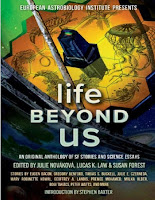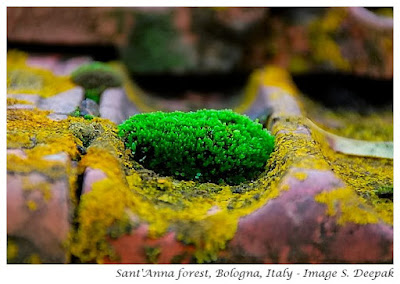I like beautifully coloured minerals and I like to learn about ancient beliefs about the power of different minerals. For example, in India, based on people's astrological birth-charts, they are advised to wear certain mineral-stones to build up their positive energies and to counteract the negative influences.
However, minerals have also played a fundamental role in the human history. In my first post about the Geo-Mineralogic Museum (GMM) of Schio, their president Alessandro Sella had talked about the mineralogical history of Schio and surroundings starting from the Copper age mines.
This post is about some specific minerals from Schio and its surrounding areas. It also has information about 6 of my favourite exhibits from the GM museum.
Alessandro Sella about local minerals of Schio in the Museum
I asked Alessandro Sella, president of the to tell me about the exhibits of the local areas around Schio.
Alessandro: We have samples of the oldest Quartzite rocks present in this area, which are metamorphic rocks (1) primarily composed of quartz. These have more than 300 million years. These can be found in Pasubio valley, Torre Belvicino, Recoaro Terme, etc. They are important because these are the base for all the successive sedimentation leading to our mountains.
Then we have Yohansenite, a mineral found in Monte Civillina in our territory, which is recognised widely. For example, I found references to it in a book in Ottawa.
Around 15 years ago, some of our members, while on an excursion in Monte Trisa in Valle dei Mercanti, came across an old mine-complex, where the rare mineral Laurelite, as well as corkite and lanarkite were found.
We also have the quarries of Pearl-grey Marble in Val Posina along th Astico river, as well as in Ronchetta (in the Pasubio valley). These abandoned quarries were active around mid-18th century, and this marble was used also for the altar of the church in Valle del Pasubio.
Then there is the Sandstone of Val Gardena, which is a sedimentary rock that comes to the surface in the Pasubio valley and Torre Belvicino, cut into round-shaped stone disks with lathe machines, which were used for sharpening knives and scissors, as this sandstone is formed by sand which is rich in quartz, which is one of the toughest stones (7th on the Morse scale). The image below shows quarzite and sandstone specimens in the GM museum. (You can click on all the images for a bigger view)
We also have the Agate stone (a kind of Chalcedony) found in the Timonchiello torrent which joins Timonchio, and comes down from San Rocco under the Tretto area of Schio. Agate is also a quartz, it is very beautiful stone even if the ones in Schio are not as colourful like the ones found in Brazil.
Among the precious stones, not so much in economic terms but in scientific terms, we have Pink Quartz from Campo Grosso. Then we have brucite (magnesium hydroxide) and magnetite (ferrous oxide), both from the pearl-grey marble quarries. We also have zircon (zirconium silicate) found in the caves of Novale.
Among the minerals from other parts of the world, we have some big and imposing looking Amethyst from Brazil, which is a quartz stone in a shade of violet colour.
My Personal favourite 6 minerals from GMM
To conclude this presentation of GM Museum of Schio, let me talk about 6 of my personal favourites.
Malachite: In the museum, there are two rocks with Malachite from Namibia with beautiful velvety looking green deposits over white crystals. It is composed of copper carbonate hydroxide. The name comes from Greek and literally means Mallow-green because it has the colour of Mallow leaves. Since ancient times, Malachite was used to produce copper as well as, used as a semi-precious stone. It was also used as a green pigment in paints.
Xonotlite: The specimen in the museum is from Spagnago, south of Valdagno, not far from Schio. It is an ino-silicate mineral with prismatic or needle like crystals. Xonotlite is a luminescent mineral, producing grey-white florescence in short UV light. I like its creamy and chalky white flower-like appearance.
Blue Smithsonite: The beautiful turquoise blue rock in the museum is from Sardinia. The zinc containing smithsonite mineral comes in different colours. It was discovered in 1802 by James Smithson, the person who donated money for the creation of the famous Smithsonian museum in the USA. People who believe in powers of crystals, say that it helps to calm the mind and they recommend it for anxiety, depression, low energy and even, shyness.
Iron Pyrite: It is also called Fool’s gold. Schio’s GM museum has different samples of this minerals, which were found when the tunnel connecting Schio and Valdagno was built in the 1990s. It is an iron sulfide mineral, with a metallic brass-yellow hue. Striking against pyrite can produce a spark and in 16-17th centuries, it was used in firearms.
I especially like the sample of reticulate pyrite found near Schio, it looks like a shining lace overlaid on a black rock (in the bottom-right part of the image below - click on the image for a bigger view).
Rhodochrosite: This red coloured manganese carbonate mineral sample in the museum is from Peru. Its name comes from Greek, Rhodo means Red, and Chrosite means coloured. For people who believe in the power of crystals, this stone is good for getting love and compassion and it is supposed to help you get over heart-break.
Crocoite: The beautiful saffron-red prismatic needle like crystals of Crocoite are from Tasmania in Australia. It is a lead-chromate mineral. Its name comes from the Greek “crokos” which means saffron. It is too delicate for jewellery, while people believing in the power of crystals use it for energy, vitality and detoxification.
In Conclusion
If you want to visit the GM Museum in Schio, it is located in the old Cella Barracks on Via Pasubio, not far from the city centre. The museum is open on saturday afternoons from 3 to 7 PM and entrance to the museum is free.
When I had asked Alessandro about the name of Monti d'Oro (Gold mountains) near Schio, he had told me that it was only a legend and gold had never been found in this part of Italy. However, this area is rich in iron pyrite, which is also called Fool's Gold. Looking at the samples found in the Schio-Valdagno tunnel, they do look shiny like gold. Thus, I was thinking that may be the toponym Monti d'Oro had come from pyrite rocks. What do you think?
I also think that apart from the scientific and practical curiosity about rocks and minerals, since ancient times, human beings also associate specific, or even magical, powers with some minerals, and create stories, legends and myths about them. I think that a guided tour of the GM museum, which touches on those myths and legends about the minerals in GM museum would be very interesting.
If you visit this museum, do share your experiences in the comments below. You may also like to check my earlier post about this museum where I had spoken to Alessandro Sella, president of the GM Museum.
*****
Notes 1. Metamorphic rocks are formed when existing rocks are altered by heat, pressure, or chemical reactions deep within the Earth which changes the rock's mineralogy, texture, and chemical composition.





































